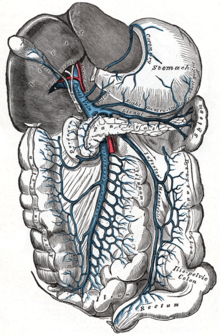Mesenteric vein
As mesenteric veins ( Latin vena mesenteric , synonymous with "intestinal vein", "Gekrösevene") are veins called the oxygen-poor, but nutrient-rich blood from the intestinal wall ( mucosa ) via the portal vein into the liver carry. Humans have two large mesenteric veins that collect venous blood from the corresponding intestinal sections: the superior mesenteric vein (“upper mesenteric vein”) and the inferior mesenteric vein (“lower mesenteric vein”). Typically, the leads inferior mesenteric vein in the splenic vein (splenic vein), which after combination with the superior mesenteric vein forms the portal vein.
- The superior mesenteric vein transports blood from the jejunum (jejunum), Hüftdarm (ileum), cecum (cecum), ascending colon (ascending colon) and transverse colon (transverse colon), and obtains inflows of veins of the duodenum (the duodenum) and the pancreas (pancreas ).
- The inferior mesenteric vein carries blood from the descending colon (colon), the sigmoid loop (colon sigmoideum) and the rectal venous plexus (a plexus of veins that surrounds the rectum , part of the rectum).
literature
- A. Benninghoff: Anatomy 1 . 17th edition. Urban & Schwarzenberg near Elsevier, 2008, ISBN 3-437-42342-8 , p. 703 ( books.google.de ).
